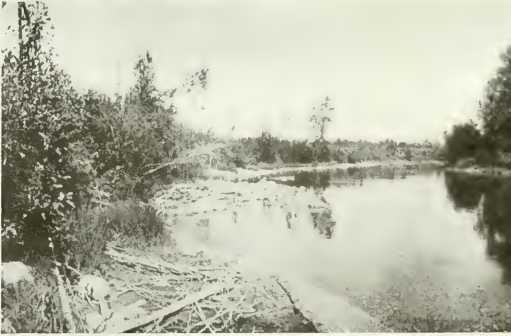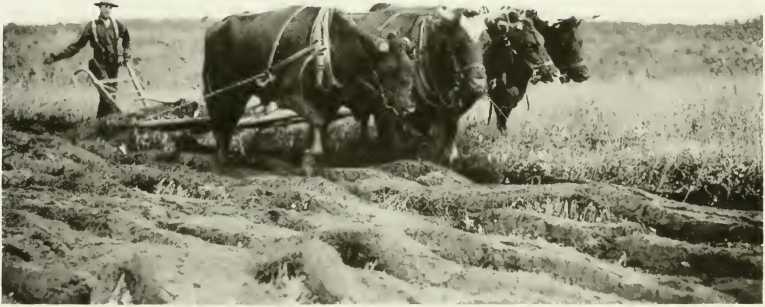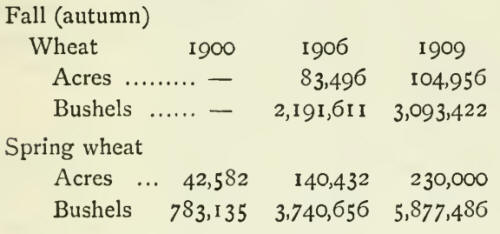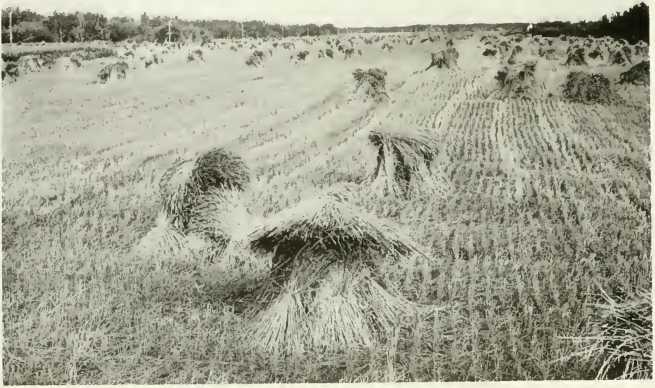|
Through prairies to
Rockies—Portage le Prairie—Regina —Government offices and mounted
police—Climate—Growth of railways—Saskatchewan Province — Census returns
of industries — Moose Jaw — Alberta Province—Uncultivated
millions—Picturesque forests and streams—The home of the buffalo—Four
great rivers—Misconceptions of climate—The heat line—The “chinook”—Wild
grasses—Cattle rearing— Cereal productions—Exhibition medal awards—Wheat
returns —Clover—Sheep and wolves—Horse breeding—Champions at the World’s
Fair—Calgary—Democratic principles—Ranching and lumbering—The Bow and
Kananaskas Rivers.
JOURNEYING from
Winnipeg by the Canadian Pacific Railway, the great plain stretches to
the horizon. Its topographical features are varied by lakes and rivers,
but the general sense of flatness is so great that the traveller is
unconscious of the fact that in the first fifty miles there has been a
gradual ascent of 100 feet.
For many miles westward
Winnipeg leaves its impress on industrial life, repeating itself in
agriculture and commercial enterprise. At Portage le Prairie a busy
grain market is indicated by huge elevators and agricultural plant.
Mills and factories show activity in other branches of trade. At Brandon
there are large flour and planing mills, and a

THE SWAN RIVER
Dominion experimental
farm; it is a town of 13,000 inhabitants, in close touch with the
markets.
Hegina, the capital of
Saskatchewan, marks a further advance in trade and civilization, and is
a connecting link between the northern and southern portions of the
province. The Government offices are located there, and the
Lieutenant-Governor’s residence is a conspicuous building on the
right-hand side of the line. It Is in keeping with law and order that
the mounted police should be stationed in the same place. The Government
buildings are an imposing suite which cost £300,000.
Saskatchewan lies in
the same latitude as the British Isles. Owing to the influence of the
Gulf Stream our own climate is largely exempt from extremes.
Saskatchewan is of equable temperature, but for other reasons. It has a
dry, clear atmosphere owing to its elevation above the sea, and is free
from destructive storms. Summer heat averages about ninety degrees, but
the winter is cold and dry. Railway accommodation has kept pace with the
rapid growth of the settlements.
The province of
Saskatchewan covers nearly 230,000 square miles. The Northern division
is traversed by the Canadian Northern and Grand Trunk Railways. The
South-Eastern portion is an extension of the grain lands of Manitoba,
embracing the wheat plains of Regina and Moose Jaw. The part lying
between the Alberta boundary and Swift Current
and stretching to the
international boundary-line, is occupied chiefly by ranchers. It is
especially suited to the rearing of cattle on account of the abundance
of “buffalo grass.” This is a short herbage on which cattle can thrive
all the year without any other fodder. The Cypress Hills constitute a
sheltered area admirable for stock farming. What is known as the
“chinook” wind, which blows from the Pacific ocean across the Rockies,
prevails in that locality, and is advantageous.
Between the north and
south branches of the Saskatchewan River lie vast prairie lands, which
in due season are likely to yield extensive crops. So far it is only a
vast area of possibilities. Its soil is rich in the ingredients which
nourish wheat plants; the climate is dry, and there is an absence of
insect pests. Flax cultivation is very profitable, and crops can be
relied upon from the first year. One notices these all along the railway
track. In the great forest belt beyond the Qu’appelle River, there are
areas suited to the raising of live stock or mixed farming. In the
central division of the province, cattle and sheep require sheltering
for the winter months, and sheep succeed best in small flocks.
The official returns
indicate the growth of these and other industries. The Dominion census
for 1901 reports 217,053 cattle and in 1906, 472,854, an increase of
255,801 in five years ; 300,000 lbs. of wool are shipped every year.
There appears to have
been no diminution in the yields of crops from the time of the earliest
settlers. The soil is clay, covered with 18 inches of rich loam,
constituting an excellent bed for seed, and producing No. i hard wheat,
for which Western Canada is famous.
Regina is a rapidly
growing city and has a population of about 32,000 people.
Moose Jaw is 40 miles
beyond the Saskatchewan capital. The origin of the name is associated
with a legend of an enterprising wagoner who mended his cart with a
moose jaw-bone. It is rich in storehouses and stock-yards connected with
the grain-growing area. The growth of the population and the prosperity
of trade in this part of the province has resulted in the laying down of
a branch line which takes a north-westerly course to meet the
requirements of agriculture. The extension of this line to Lacombe in
Alberta is already projected. As an example of rapid growth, Mountain
Lake district in the vicinity may be cited. In 1901 its population was
256; in 1906 it grew to 23,553.
Alberta is one of the
two provinces that sprang out of the great plain lying between the
Rockies and the great lakes. In extent it is greater than Germany or
France, and Texas is the only one of the United States which exceeds it
in size. It lies in the same zone as northern and central Europe, and
its climate is similar to that of the countries within those latitudes.
During its short
existence, its wealth and population have made rapid strides, and it is
an example of young Canada growing with the advantages of the training
of the Mother Country, and applying the experience to the new
opportunity which the province affords.
Alberta contains over
160,000,000 acres of land, 100.000.000 of which are available for
settlement. In 1909 only one per cent, was under cultivation. It is a
vast undulating tableland, gently inclining towards east and north, and
picturesquely set out with forest, hills and streams. Everywhere there
are lovely lakes, yielding an abundant revenue of white fish. It was
once the feeding-ground of the countless herds of buffalo, which were
attracted to that region by the rich pastures. Alberta is well watered
by great rivers. The Saskatchewan, with eleven tributaries t which form
two branches, one irrigating the south, the other the north and central
plains. The Peace River and the Athabasca, two huge watercourses of the
Mackenzie basin, drain between them an area of 1.000.000 square miles.
The Hay River forms the quartette of this combined watershed.
The climate has been
depreciated, especially in English literature, by an erroneous notion
that a rich fur trade was associated with Arctic conditions, and that
Alberta, lying so far north, must be a region of ice and snow. When the
Canadian Government dispatched its explorers they discovered that the
habitat of the
fur-bearing animals was thousands of miles removed from the wheatfields
of Alberta. The heat during the summer is equally distributed throughout
the province. The rainfall takes place in May, June and July; and during
the harvesting months dry weather may be reckoned on unhesitatingly. It
is a common mistake to judge climate by latitude. Other forces
materially affect it. Wind currents from land and sea, and thousands of
square miles of high barren plains have a modifying effect over the
entire province as far as the Arctic Circle. The line of greatest heat
passes over Port Vermillion, 500 miles north of Edmonton, and 800 miles
from the States boundary-line.
The chinook, a
delightful breeze from the sea, is said to have a beneficial effect on
the crops. In proof of the friendly climatic conditions, the official
reports pointed out that the Indians lived for ages in these northern
regions, and pitched their wigwams on the banks of the Athabasca and
Saskatchewan, and wintered their horses on the unsheltered plains.
The North-West Mounted
Police, which were organized in 1874, and are intimately acquainted with
the province, confirm these reports. Two members of the force, whom I
met on my homeward journey, described it as the finest climate in the
Dominion. From the first of June to the first of August there are only
two hours of darkness in the twenty-four. Wild grass is so good that
there is no need to cultivate it. In the autumn, thousands of stacks may
be seen. There is no rain to spoil the making. A variety of blue grass
highly valued by cattle owners, grows in many districts, and the
well-known Kentucky species is said to flourish better there than in its
native soil.
The ingredients of the
land consist of marly clay of great depth, overlaid with rich black
absorbent soil, which chemical analysis has shown to possess all the
plant foods, with almost a complete absence of stones. The latter
feature greatly reduces the cost of breaking up the soil, and the steam
plough effects the process at a cost of 15J. to 25s. per acre. Cattle
grazing is carried on under favourable conditions, as there is no winter
slush, and the animals thrive and grow fat. In April the snow clears,
and spring opens, often with a breath of the chinook winds, which raises
the temperature almost to summer heat.
It is as a
cereal-producing province that Alberta is likely to be distinguished in
the future. The British Association meeting at Winnipeg, August, 1909,
pointed out that it is par excellence the wheat belt of the continent,
and just as other areas of the United States have become celebrated as
the corn belt of the continent, the provinces of the Canadian West will
become the great wheat-producers for the United States and Great
Britain. At the exhibition at Philadelphia in 1876, a medal was taken
for wheat grown 750 miles north of the international boundary

line; and at the
World’s Columbian Exhibition, 1893, the highest award was given for
wheat grown in the Peace River valley.
The following returns
show the progress made between 1900 and 1909 :—

Alberta also grows a
fine quality of oats. Fifty to sixty bushels an acre are a general
yield, sometimes running up to 100 bushels. Thirty-four pounds is the
standard weight for a bushel of oats. At the Provincial Seed Fair in
1909, a bushel weighing 50 lb. took the first prize. Alberta invaded
Paris, and took the highest award for oats at the last exhibition. The
increase in the production of this important cereal has been from
3,000,000 to 24,000,000 bushels in nine years.
The province yields two
or three different kinds of clover, which command a high price. The
timothy species yields from two to three tons an acre, and is sold at
from £2 10s. to £3. Alfalfa commands the highest price.
The fertility of the
soil, singularly enough, is attributed to the climate, which at one time
was regarded as inimical to agricultural interests. Prof. Macoun, of the
Canadian Geological Survey, points out that as long as the West is
blessed with winter frosts and summer rains, so long will teeming crops
be the product of her soil. The frosts help to crumble it; the rain and
sunshine do the rest. Artificial means of nourishing are unnecessary,
the grain entrusted to its keeping has eighteen inches to feed on.
It naturally follows
that the conditions that prevail in Alberta supply the best advantages
for the rearing of live-stock. The breaking up of the soil has also been
instrumental in disbanding the enormous herds of cattle belonging to the
old ranching days. Cattle-feeding on a smaller, and from the farmers’
point of view more efficient, scale is carried on as a remunerative
industry. The demand for home-grown beef is exceeding the supply.
Sheep are kept nearer
home, and are no longer the prey of the destructive coyote. A good
wolfhound or two are a sufficient provision against that. The reward
given by the Government for the wolfs head has tended to put a check on
the depredations of the thief.
Success in
horse-breeding has been marked of recent years. The heavy draught teams
seen in the towns and cities indicate this. At the Pan-American
Exhibition, and the New York Horse Show, the champion hackney came from
Calgary. At the

World’s Fair at St.
Louis in 1904, the champion stallion and mare were raised in Alberta.
From Calgary to
Saskatoon a new branch of the Canadian Northern Railway is about to be
opened. It traverses a tract of rich fertile prairie on which towns are
clustering with great rapidity. The laying down of rails and the growth
of towns follow as cause and effect. The traveller who found nothing but
the most primitive railway station on this newly-constructed track one
year, and passing the same way a year later, would fine a population of
one thousand people and all the bustle of a thriving town. This is
precisely the case of Kindersley.
Saskatoon, the starting
point of this branch, in 1903 consisted of 113 souls. In seven years it
developed into a population of 13,000, and possesses all the advantages
of a university, an agricultural college, and five schools.
From Swift Current to
Medicine Hat the Canadian Pacific line skirts hills rising to a
considerable altitude. The route leads through the valley of the South
Saskatchewan River. Fruit-farming, for which the district is
particularly adapted, is carried on there. The industry is fostered by
the Government, which works a model farm in the district. All along the
journey to Calgary the great plains hold the monopoly. Rivers, lakes,
and occasional distant rising slopes are passing incidents. It is
prairie, prairie, boundless prairie on both sides of the train for days.
Great plains roll away
before the eyes, untouched by human hand, unbroken by agricultural
implement, as virgin as when the primeval light fell on them. Here and
there a solitary homestead comes into sight, but the lonely pioneer of
civilization only emphasizes the awful sense of detachment. Herds of
cattle raise their startled heads in mute surprise at the invader.
Horses swish their long tails and with ears erect make ready for a
stampede. At intervals a golden cornfield flashes into sight, and a
wagon drawn by a team of horses, carts sheaves for threshing. A crow,
whose solitary habits were in keeping with the loneliness, idly flitted
across the scene. Of other signs of animal life there were few. Prairie
chickens found sufficient covering in the standing corn or sheaves to
hide themselves from view. Gophers, po-ta-chi-pin-gwa-si, “the thing
that blows up the loose earth,” as the Saltaux Indians call them, were
seen close to the railway cutting, reared on their hind legs and gazing
in curiosity, as if daily intercourse with the new order of things had
blunted their timidity. We were on the look-out for larger game, but saw
nothing but a badger, which dodged behind loose stones and soon
disappeared.
Calgary takes a place
second only to Winnipeg. It has a population of over 60,000, and has
progressed so far in democratic principles as to municipalize its
tram cars and electric
lighting. It is an active centre of ranching and lumbering.
The railway journey
takes the course of the Bow River, and a gradual ascent is made towards
the mountain region. The Kananaskas River mingles its waters with that
of the Bow a little further on, and the united force is concentrated in
the roar of the Kananaskas Falls.
This waterway is
drafted into service for purposes of irrigation as well as serving
Calgary for the transportation of its lumber. Through the Gap there is a
splendid view of the Bow River up-stream. The mountains on both sides
lean across as if they were about to form a natural rock bridge, but
stop abruptly as if they had suddenly changed their mind. A vulture
flitted between them as our train sped by. |
